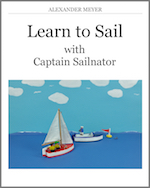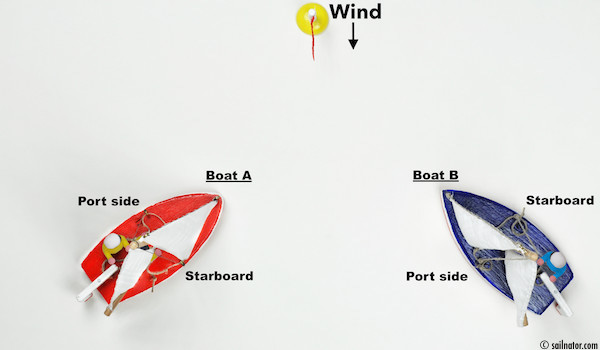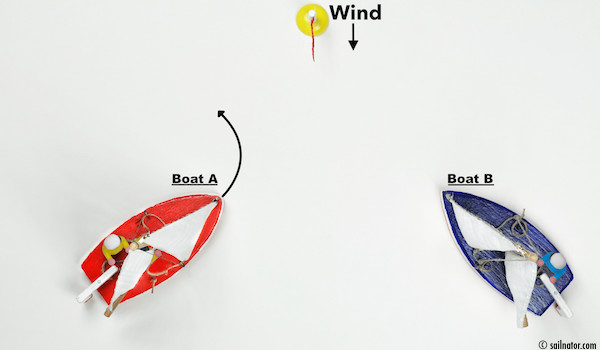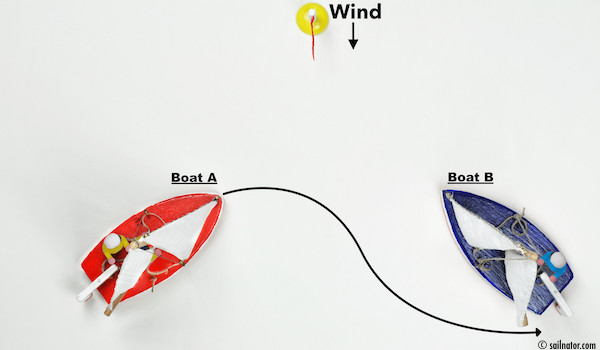In the next three chapters I will explain the rules of the road between sailboats and you. We are mostly not alone on the water and we often cross the courses of other boats. But what do we do when two sailboats approach each other and there is the risk of colliding? On the water the rules for this situation are: One boat has to keep out of the way of the other (the give-way vessel) and one has to stay on its course (the stand-on vessel). A real right of way only exists in limited cases.
I will explain the general rules we have to observe, if no other rule applies. As always we have to inform ourselves about the local rules before sailing in unknown waters. In the overwhelming amount of places the “Conventions on the International Regulations for Preventing Collisions at Sea (COLREGs)” apply. But sometimes the left boat has to give way to the right boat. On inland waterways and specially designated shipping lanes there might be different rules.
 This online sailing course has also been published as ebook and paperback. For more information click here!
This online sailing course has also been published as ebook and paperback. For more information click here!
You can download the Ebook for example at:
iTunes UK & iTunes US | iBooks for iPad and Mac
Amazon.com & Amazon.co.uk | Kindle-Edition
Google Play | for Android
The paperback is available for example at:
Amazon.com | Amazon.co.uk
As I said before where there is risk of a collision there is always one that has to keep out of the way and one that has to stand on. It is important to understand that you do not insist on having the right of way. But why is it so important that one boat has to keep its course and speed and “stand on” the original course?
The give-way vessel has to be able to rely on the stand-on vessel to keep its course. Otherwise it cannot plan any evasion manoeuvre. It must not be confronted with the problem that the whole situation changes after a short while. But it has to conduct the evasion manoeuvre with ample time and it has to be clearly identifiable and determined. The stand-on vessel has to be able to clearly make out that the give-way vessel really stays out of the way. I now explain the rules between sailboats that apply if no other rule applies.
The first rule is taken from the “Conventions on the International Regulations for Preventing Collisions at Sea (COLREGs)” and says: “When two sailing vessels are approaching one another, so as to involve risk of collision, one of them shall keep out of the way of the other as follows: when each has the wind on a different side, the vessel which has the wind on the port side shall keep out of the way of the other.” (Indication of source: United States Coast Guard, Navigation Rules, 01.02.2015)

Figure 115: Two sailing vessels approach one another with a risk of collision and each has the wind from a different side. Which one has to stand on and which one has to give way?
How does that work in reality? Just remember that a boat that has the wind on port side is sailing on port tack and a boat that has the wind on starboard is sailing on starboard tack. Let us now have a look at the figures to understand this rule. Which boat on figure 115 has the wind on port side … ? Right, boat A. It is sailing on port tack. And how can it keep out of the way of boat B? Which possibilities does it have to do so … ?
It can slow down and reduce speed to keep out of the way of the other boat. Or it can change the course and go through behind the stern of boat B. (Figure 117) Or it can tack. (Figure 116)

Figure 116: Boat A has the wind on port side and has to keep out of the way. Either by tacking …
It is always safe to head towards the stern of the “opponent” and to follow it with our bow. But as I said before this has to happen clearly identifiable, determined and with ample time. In absolutely no case should we count on being the faster boat and try to go through in front of the other boat’s bow.

Figure 117: … or by going through behind the stern of Boat B!
But how can we recognise quickly if we have to give way or stand on. The sentence: “When two sailing vessels are approaching one another, so as to involve risk of collision, …” is quite long and not easy to remember. Some say: Port tack gives way to starboard tack. This means: The boat that sails on port tack (and has the wind on port side) gives way to the boat sailing on starboard tack. But what beginner knows where port side and where is starboard in all this stress? It might be easier to remember:
Sail left has right! (of way)
By “sail” the mainsail is meant! So if we realise there could be a risk of collision with another sailboat we first have a look up at our mainsail. If it is on the left side of our boat (when facing the bow) it is a good sign. Now we only have to look where the “opponent” has their sails. If they are on the right side, the other boat has to give way and we have to stand on. If our sail is on the right side, and the opponents on the left side it is the other way round.
But what happens when both boats have the sail on the same side and get the wind from the same direction? That, I will explain to you in the next chapter.
← Last chapter | Next chapter →
All chapters: Technical Terms | The theory behind sailing |Close-hauled | Beam reach | Broad reach | Sailing downwind | Tacking | Beating | Quick-turn | Sailing up head to wind | Man overboard | Jibing | Heaving-to | Leaving the dock | Berthing | Rules of the road 1 | Rules of the road 2 | Rules of the road 3 | Reefing | Capsizing